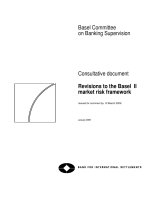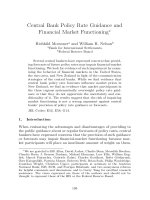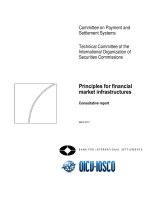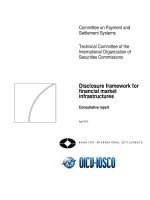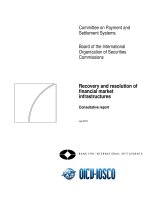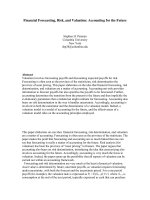Financial market risk
Bạn đang xem bản rút gọn của tài liệu. Xem và tải ngay bản đầy đủ của tài liệu tại đây (3.49 MB, 493 trang )
Financial Market Risk
What is financial market risk? How is it measured and analyzed? Is all financial
market risk dangerous? If not, which risk is hedgeable?
These questions, and more, are answered in this comprehensive book written
by Cornelis A. Los. The text covers such issues as:
•
•
•
•
•
competing financial market hypotheses;
degree of persistence of financial market risk;
time–frequency and time–scale analysis of financial market risk;
chaos and other nonunique equilibrium processes;
consequences for term structure analysis.
This important book challenges the conventional statistical ergodicity paradigm
of global financial market risk analysis. As such it will be of great interest to
students, academics and researchers involved in financial economics, international
finance and business. It will also appeal to professionals in international banking
institutions.
Cornelis A. Los is Associate Professor of Finance at Kent State University, USA.
In the past he has been a Senior Economist of the Federal Reserve Bank of
New York and Nomura Research Institute (America), Inc., and Chief Economist
of ING Bank, New York. He has also been a Professor of Finance at Nanyang
Technological University in Singapore and at Adelaide and Deakin Universities in
Australia. His PhD is from Columbia University in the City of New York.
Routledge International Studies in Money and Banking
1 Private Banking in Europe
Lynn Bicker
2 Bank Deregulation and
Monetary Order
George Selgin
3 Money in Islam
A study in Islamic political
economy
Masudul Alam Choudhury
4 The Future of European
Financial Centres
Kirsten Bindemann
5 Payment Systems in Global
Perspective
Maxwell J. Fry, Isaak Kilato,
Sandra Roger, Krzysztof
Senderowicz, David Sheppard,
Francisco Soils and John Trundle
6 What is Money?
John Smithin
7 Finance
A characteristics approach
Edited by David Blake
8 Organisational Change and
Retail Finance
An ethnographic perspective
Richard Harper, Dave Randall and
Mark Rouncefield
9 The History of the
Bundesbank
Lessons for the European
Central Bank
Jakob de Haan
10 The Euro
A challenge and opportunity
for financial markets
Published on behalf of Société
Universitaire Européenne de
Recherches Financières
(SUERF)
Edited by Michael Artis,
Axel Weber and Elizabeth
Hennessy
11 Central Banking in Eastern
Europe
Nigel Healey
12 Money, Credit and Price
Stability
Paul Dalziel
13 Monetary Policy, Capital Flows
and Exchange Rates
Essays in memory of
Maxwell Fry
Edited by William Allen and
David Dickinson
14 Adapting to Financial
Globalisation
Published on behalf of Société
Universitaire Européenne de
Recherches Financières (SUERF)
Edited by Morten Balling,
Eduard H. Hochreiter and
Elizabeth Hennessy
15 Monetary Macroeconomics
A new approach
Alvaro Cencini
16 Monetary Stability in Europe
Stefan Collignon
17 Technology and Finance
Challenges for financial markets,
business strategies and policy
makers
Published on behalf of Société
Universitaire Européenne de
Recherches Financières (SUERF)
Edited by Morten Balling, Frank
Lierman and Andrew Mullineux
18 Monetary Unions
Theory, History, Public Choice
Edited by Forrest H. Capie and
Geoffrey E. Wood
19 HRM and Occupational Health
and Safety
Carol Boyd
20 Central Banking Systems
Compared
The ECB, The pre-Euro
Bundesbank and the Federal
Reserve System
Emmanuel Apel
21 A History of Monetary Unions
John Chown
22 Dollarization
Lessons from Europe for the
Americas
Edited by Louis-Philippe Rochon
and Mario Seccareccia
23 Islamic Economics and Finance:
A Glossary, 2nd Edition
Muhammad Akram Khan
24 Financial Market Risk
Measurement and analysis
Cornelis A. Los
Financial Market Risk
Measurement and analysis
Cornelis A. Los
First published 2003
by Routledge
11 New Fetter Lane, London EC4P 4EE
Simultaneously published in the USA and Canada
by Routledge
29 West 35th Street, New York, NY 10001
Routledge is an imprint of the Taylor & Francis Group
This edition published in the Taylor & Francis e-Library, 2005.
“To purchase your own copy of this or any of Taylor & Francis or Routledge’s
collection of thousands of eBooks please go to www.eBookstore.tandf.co.uk.”
© 2003 Cornelis A. Los
All rights reserved. No part of this book may be reprinted or reproduced or
utilized in any form or by any electronic, mechanical, or other means, now
known or hereafter invented, including photocopying and recording, or in
any information storage or retrieval system, without permission in writing
from the publishers.
British Library Cataloguing in Publication Data
A catalogue record for this book is available from the British Library
Library of Congress Cataloging in Publication Data
Los, Cornelis Albertus, 1951Financial market risk : measurement & analysis / Cornelis A. Los.
p. cm. – (Routledge international studies in money and banking ; 24)
Includes bibliographical references and index.
1. Hedging (Finance) 2. Risk management. I. Title. II. Series.
HG6024.A3L67 2003
332’.01’5195–dc21
ISBN 0-203-98763-2 Master e-book ISBN
ISBN 0–415–27866–X (Print Edition)
2003040924
To
Janie and Klaas Los, Saba and Leopold Haubenstock, and P. Köhne
with
Gratitude for life, liberty and the pursuit of happiness
Contents
List of figures
List of tables
Preface
Introduction
xiii
xix
xxi
xxvii
PART I
Financial risk processes
1 Risk – asset class, horizon and time
1.1 Introduction 3
1.2 Uncertainty 7
1.3 Nonparametric and parametric distributions 17
1.4 Random processes and time series 31
1.5 Software 41
1.6 Exercises 41
1
3
2 Competing financial market hypotheses
2.1 Introduction 47
2.2 EMH: martingale theory 47
2.3 FMH: fractal theory 53
2.4 Importance of identifying the degree of market efficiency 65
2.5 Software 67
2.6 Exercises 67
47
3 Stable scaling distributions in finance
3.1 Introduction 71
3.2 Affine traces of speculative prices 72
3.3 Invariant properties: stationarity versus scaling 76
3.4 Invariances of (Pareto–Lévy) scaling distributions 77
3.5 Zolotarev parametrization of stable distributions 80
3.6 Examples of closed form stable distributions 92
71
x
Contents
3.7
3.8
3.9
Stable parameter estimation and diagnostics 94
Software 96
Exercises 97
4 Persistence of financial risk
4.1 Introduction 102
4.2 Serial dependence 102
4.3 Global dependence 105
4.4 (G)ARCH processes 111
4.5 Fractional Brownian Motion 117
4.6 Range/Scale analysis 120
4.7 Critical color categorization of randomness 122
4.8 Software 128
4.9 Exercises 128
102
PART II
Financial risk measurement
133
5 Frequency analysis of financial risk
5.1 Introduction 135
5.2 Visualization of long-term financial risks 135
5.3 Correlation and time convolution 136
5.4 Fourier analysis of stationary price innovations 141
5.5 Software 152
5.6 Exercises 152
135
6 Fourier time–frequency analysis of risk
6.1 Introduction 155
6.2 FT for aperiodic variables 156
6.3 Hurst exponent identification from risk spectrum 169
6.4 Heisenberg Uncertainty Principle 171
6.5 Windowed FT for transient price innovations 173
6.6 Software 186
6.7 Exercises 186
155
7 Wavelet time–scale analysis of risk
7.1 Introduction 190
7.2 Wavelet analysis of transient pricing 192
7.3 Mallat’s MRA 209
7.4 Wavelet Parseval Risk Decomposition Theorem 223
190
Contents
7.5
7.6
xi
Software 224
Exercises 224
8 Multiresolution analysis of local risk
230
8.1 Introduction 230
8.2 Measurement of local financial market risk 237
8.3 Homogeneous Hurst exponents of monofractal price series 250
8.4 Multiresolution analysis of multifractal price series 265
8.5 Software 281
8.6 Exercises 281
PART III
Term structure dynamics
9 Chaos – nonunique equilibria processes
9.1 Introduction 289
9.2 Logistic parabola regimes 292
9.3 General nonlinear dynamic systems 317
9.4 Detecting attracting points and aperiodic orbits 327
9.5 Summary of aperiodic cyclical steady-state equilibria 328
9.6 Software 330
9.7 Exercises 331
287
289
10 Measuring term structure dynamics
10.1 Introduction 337
10.2 Dynamic investment cash flow theory 340
10.3 Nonlinear relationships in finance 347
10.4 Liquidity and financial turbulence 358
10.5 Software 372
10.6 Exercises 373
337
11 Simulation of financial turbulence
11.1 Introduction 380
11.2 Theories of physical and financial turbulence 381
11.3 Measurement and simulation of turbulence 388
11.4 Simulation of financial cash flow turbulence 396
11.5 Multiresolution analysis of financial turbulence 398
11.6 Wavelet solutions of financial diffusion equations 402
11.7 Software 414
11.8 Exercises 414
380
xii
Contents
PART IV
Financial risk management
423
12 Managing VaR and extreme values
12.1 Introduction 425
12.2 Global dependence of financial returns 425
12.3 VaR for stable distributions 428
12.4 VaR for parametric distributions 431
12.5 Extreme value theory 437
12.6 VaR and fractal pricing processes 440
12.7 Software 445
12.8 Exercises 445
425
Appendix A: original scaling in financial economics
Appendix B: S&P500 daily closing prices for 1988
449
450
Index
453
Figures
1
1.1
1.2
1.3
1.4
1.5
1.6
1.7
1.8
1.9
1.10
1.11
1.12
1.13
1.14
1.15
2.1
2.2
2.3
2.4
2.5
2.6
Risk = Danger (Wei) + Opportunity (Ji)
Historical average annual returns and return volatility
Levels and returns of empirical financial time series: AMEX
stock and oil indices and DEM–USD exchange rate
Simple and relatively inexpensive radiation monitor
The nth-order moments and cumulants for n = 1, 2, 3, 4
of the Laplace, Gaussian and Uniform p.d.fs
The nth-order moments and cumulants for n = 1, 2, 3, 4
of Exponential, Rayleigh and K-distribution p.d.fs
Construction of the histogram of a time series by binning
Raw and transformed daily returns of the DAX. The histograms
on the right show the relative frequencies of the returns in the
same scale
Empirical histogram of minute-by-minute log-increments of the
JPY in June 1997
Volatility smile of foreign currrency options
Implied distribution and (log-) normal distribution of foreign
currency options
Skewed volatility smile of equities
Implied distribution and (log-) normal distribution
The empirical cumulative distributions for USD/DEM and USD
6 months cash interest rate, shown for different time horizons
Semi-annual cumulative distributions of THB–FX increments,
January–December 1997
Semi-annual cumulative distributions of DEM–FX increments,
January–December 1997
Annualized volatility of theoretical Random Walk model of
constant, normalized, asset return volatilities
Empirical annualized volatility of financial market returns
Mandelbrot’s Julia set
Clear-air turbulence
Intraday return variance of the HSI
Intraday return variance of the HSIF
xxx
4
9
11
21
22
24
25
25
26
26
27
28
30
36
37
55
56
58
59
61
62
xiv
2.7
2.8
3.1
3.2
3.3
3.4
3.5
3.6
4.1
4.2
4.3
4.4
4.5
4.6
5.1
5.2
5.3
5.4
5.5
6.1
6.2
6.3
6.4
6.5
6.6
6.7
List of figures
One-month Eurodollar yield and time-varying (a) turbulent
volatility and (b) daily data
Five-year CMT yield and time-varying (a) turbulent volatility
and (b) daily data
Stable probabilistic schemes
Stable density in the Zolotarev S(αZ , β, γ , δ; 0) =
S(αZ , 0.8, 1, 0; 0) parametrization
Stable density in the Zolotarev S(αZ , β, γ , δ; 1) =
S(αZ , 0.8, 1, 0; 1) parametrization
Comparison of the t = 1 minute p.d.f. for high-frequency
S&P500 price changes with the Gaussian p.d.f. and with a Lévy
stable p.d.f.
Non-convergent moving variance of 253 daily rates of return
(in 100 percent) of the S&P500 stock market index in 1998
Estimates of four parameters of the Zolotarev parametrization
of FX distributions
Successive increments of ARCH(1) simulations with the same
unconditional variance (σ 2 = 1)
Probability density function of the successive increments shown
in Figure 4.1.
Comparison of the scaling properties of the unconditional p.d.f.
of a GARCH(1, 1) stochastic process
Autocorrelograms of equally-weighted CRSP daily and
monthly stock return indices
Sample of power spectra of white, pink and brown noise
Relations between and constraints on d, H and αZ
Fourier series approximation of a square wave
Heat diffusion analysis
A sample signal constructed from sine functions representing
three pulsations
The FT of the sampled signal s(t)
Fourier series analysis of pure musical harmonics: dominant
frequencies of the clarinet, violin and bagpipe
Granger and Morgenstern’s global risk spectrum of Standard
and Poor series, based on annual data, 1875–1952
Semi-log plot of the autocorrelation function γ (τ ) for the
S&P500 index, sampled at a 1-minute time scale
Spectral density of high-frequency data from the S&P500 index
Gábor’s atom g0,ξi as a function of time for three frequencies:
(a) high ξ1 , (b) middle ξ2 and (c) low ξ3
Heisenberg boxes of two windowed Fourier atoms gu,ξ and gν,γ
Time–frequency analysis by the Gábor Transform with σ
adapted to the time coherence of frequencies ω1 and ω3
Signal, spectrograms and scalogram
63
64
78
86
87
90
90
95
114
115
117
119
125
127
144
146
150
151
151
166
170
171
176
177
180
181
List of figures
6.8
6.9
6.10
6.11
6.12
7.1
7.2
7.3
7.4
7.5
7.6
7.7
7.8
7.9
7.10
7.11
7.12
7.13
7.14
8.1
8.2
8.3
8.4
8.5
8.6
8.7
8.8
8.9
Spectrogram PS (τ, ξ ) of time series with two superimposed
time-varying frequencies
Laughter data and their global histogram
Spectrogram of laughter data with three dominant harmonics
Changes in the daily level of the three-month Treasury yield
Comparison of the modulated spectrogram of empirical
DEM/USD increments with the flat spectogram of white noise
A sine wave and a Daubechies’ wavelet ψD20
Self-similarity of wavelets: translation (every fourth k) and
scaling of a wavelet ψ
Wavelet coefficients are “correlation” or “resonance”
coefficients. Here a wavelet is correlated with an irregular
signal. Different sections of the signal produce different
resonance coefficients
A scalogram: a plot of the magnitude of wavelet coefficients
A 3D scalogram: a plot of the magnitude of the wavelet
coefficients in three dimensions
Heisenberg boxes of two wavelets. Smaller scales decrease the
time dispersion, but increase the frequency support, which is
shifted towards higher frequencies
Time–frequency resolution and basis functions of the
Windowed FT and the Wavelet Transform
A scalogram with modulus |W (τ, a)| using a Morlet wavelet
for 25 different scales
Normalized scalogram (ξ/η)PW (τ, a)
Time–scale tiling for a sinusoidal function with an isolated
singularity at t0
Empirical 3D scalogram of Thai Baht increments in July 1997
Time signal observations on f (x)
Haar and triangle scaling functions and their respective MRA
equations
Haar and triangle wavelets and their respective MRA equations
USD/DEM exchange rate on a time scale of t = 20 minutes
Scaling law behavior of the USD/DEM exchange rate in the
period 1993–1994, for various subperiods
Trading transaction density based on daily and weekly averages
of tick-by-tick data
Daily and weekly averaged volatility per hour of the USD/DEM
exchange rate
The cone of influence of an abscissa singularity ν
Singularity cones of influence of a Dirac pulse at t = t0
Wavelet decomposition of a time series with singularities
How to measure the degree of irregularity of local risk of a
series of price singularities x(t)
Complete wavelet tiling
xv
182
183
184
184
185
193
194
196
197
197
198
199
201
202
203
204
211
216
220
232
233
234
235
245
245
248
249
251
xvi List of figures
8.10 Wavelet-based persistence analysis of heartbeat interarrival
times for a healthy patient with a Daubechies(5) wavelet
8.11 Wavelet-based persistence analysis of weekly Dow Jones
Industrial Index data with Daubechies(5) wavelet
8.12 Wavelet MRA by Morlet(6) wavelet of the various exchange
rate regimes of the Mexican Peso/USD and the various
Brazilian financial market crises in the 1990s
8.13 Wavelet MRA of the various exchange rate regimes of the first
(log) differences of the Mexican Peso/USD in the 1990s
8.14 Wavelet MRA, based on daily data, of Chilean stock index rate
of returns in the 1990s
8.15 The first four monthly moments of the distributions of the
minute-by-minute quotations of nine currency rates in
May–August 1997 (USD is the numéraire)
8.16 Development of Koch’s snowflake with Hausdorff dimension
D = 1.2619
8.17 Schematic convex multifractal singularity spectrum D(αL ),
with various Gibbs exponent regimes
8.18 Computation of singularity spectrum of the devil’s staircase, its
partition function Z(q, a) scaling exponents τ (q) and its
theoretical spectrum D(αL )
8.19 Wavelet MRA of Fractional Brownian Motion
8.20 Time-warped Geometric Brownian Motion
8.21 Multifractal spectrum analysis of time-warped GBM
8.22 Mandelbrot’s early multifractal turbulence trace modeling in a
laboratory experiment
8.23 Multifractal spectrum of physical (windtunnel generated)
turbulence
8.24 Turbulent correlation between the S&P500 spot and futures
market, 1982–1991
9.1 Nonunique dynamic equilibria of the logistic parabola
9.2 The Hurst exponent may not be the best measure of the global
dependence of intermittent and chaotic processes
9.3 The various stability regimes of the logistic process are
determined by the value of the scaling parameter κ
9.4 When a dynamic process is chaotic, its later values are directly
dependent on the precision of its initial condition
9.5 After a fixed attraction point turns unstable, an orbit of period
length p = 2 emerges
9.6 Period-doubling appears first at a scaling parameter value just
above κ = 3
9.7 The relationship between the parabolic map f (x) for an orbit of
period length p = 2 and the 1× iterated map f (2) (x)
9.8 Oscillation of the logistic process between two steady-state
equilibria at x ∗ = 0.5 and x ∗ = 0.809
254
256
257
260
261
264
267
271
274
275
276
277
278
279
280
296
297
298
299
301
302
303
304
List of figures
9.9
9.10
9.11
9.12
9.13
9.14
9.15
9.16
9.17
9.18
9.19
9.20
9.21
9.22
9.23
9.24
9.25
9.26
9.27
9.28
9.29
9.30
The 1× iterated map f (2) (x) for period length p = 4, with
2 × 2 stable steady-state equilibria and one unstable equilibrium
Oscillation of the logistic process between four steady-state
equilibria at x ∗ = 0.5, 0.875, 0.383 and 0.827, respectively
The 2× iterated
parabolic map for the scaling parameter
√
κ = 1 + 8 + 10−3
A sample window of 100 observations of an undefined orbit, or
frequency, of infinite period length with scaling parameter
κ = 3.6
Intermittency in time series is characterized by periods of
stability alternating with periods of chaos
The reappearance of a period of apparent stability
Another period of apparent stability with periodicity with six
steady-state equilibria
Another instance of intermittency in the time series of the
logistic process, after the birth of period length 3
Complete chaos is defined by the coexistence of an infinite
number of deterministic unstable equilibrium orbits
Complete logistic chaos consists of infinitely many coexisting
steady-state dynamic equilibria and is not white noise
Complete chaos exhibits infinitely many aperiodic oscillations
with each oscillation having its own amplitude
Complete chaos exhibits infinitely many aperiodic oscillations
with each oscillation having its own amplitude
Wavelet scalogram and scalegram of the completely chaotic
logistic parabola process with scaling parameter κ = 4.0
The trajectory of a billiard ball depends on the shape of the
elastic boundary that constraints it
The state space trajectory of a chaotic system shows aperiodic
cyclicity with non-overlapping orbits
First 10 observations of the state space trajectory of the chaotic
logistic process x(t) for κ = 4.0
First 10 observations of the steady-state equilibrium points
where the trajectory “touches” the parabolic constraint of the
chaotic logistic process x(t) for κ = 4.0
First 20 observations of the state space trajectory of the chaotic
logistic process x(t) for κ = 4.0
First 20 steady-state equilibria points on the attractor set of the
chaotic logistic process x(t) for κ = 4.0
First 50 observations of the state space trajectory of the chaotic
logistic process x(t) for κ = 4.0
First 50 steady-state equilibria points on the attractor set of the
chaotic logistic process x(t) for κ = 4.0
First 90 observations of the state space trajectory of the chaotic
logistic process x(t) for κ = 4.0
xvii
305
306
306
309
310
310
311
311
313
315
315
316
317
318
319
320
320
321
321
322
322
323
xviii List of figures
9.31 First 90 steady-state equilibria points on the attractor set of the
chaotic logistic process x(t) for κ = 4.0
9.32 The physical or institutional resource constraint of the chaotic
process determines its global, long-term predictability
9.33 A close return or recurrence plot of the Belousov–Zhabotinsky
chemical reaction
9.34 Close return histograms of (a) a chaotic time series with
aperiodic cyclicity and (b) Geometric Brownian Motion
10.1 Nelson and Siegel curve fitted to UK government bond (gilt)
rates derived from nine bonds for t0 = September 4, 1996
10.2 Vertical ocean shear at various depths
10.3 A 6-scale wavelet coeficient sequence decomposition of ocean
shear series
10.4 More than 9,300 minute-by-minute quotations on the Philippine
pesos collected in real time for the month of July 1997
10.5 Three-scale wavelet resonance coefficient series of the
minute-by-minute quotations on the Philippine pesos
10.6 The term structure gradient, TSG(t)
11.1 An indictment of global (average) statistical analysis by two
time series with the same global risk spectrum P (ω)
11.2 Simulated evolution, t = 10, 20, 40, of a 2D vortex spiral,
based on a pseudo-wavelet computation of 2D Navier–Stokes
equations
11.3 Theoretical and empirical representations of a shock wave
11.4 Data in the time domain from nine different turbulent flows
11.5 Gibbs phenomenon
11.6 Approximation of the Heaviside function f (x) in panel of
Figure 11.5, using a wavelet basis
12.1 Typical time dependence of financial price volatility, log σ 2
12.2 Empirical distribution of daily revenues of JP Morgan in 1994
12.3 Potential large-scale catastrophic flow risk: the Yangtze River
12.4 Drawing of the completed Three Gorges Dam: the spillway to
release water and control flooding is in the center
12.5 Emergence of large-scale dynamic catastrophic flow risk
management
A.1
Mandelbrot’s original evidence for scaling in economic pricing
processes
B.1
S&P500 daily closing prices taken from table 2.7 in Sherry
(1992), pp. 29–32
323
324
327
328
358
359
360
361
362
364
382
384
386
391
405
406
426
431
434
435
436
449
451
Tables
1.1
1.2
1.3
1.4
2.1
3.1
4.1
4.2
4.3
6.1
8.1
8.2
8.3
8.4
9.1
9.2
Ellsberg Paradox payoffs: Options 1 and 2
Ellsberg Paradox payoffs: Options 3 and 4
First four moments of FX returns: USD/DEM and USD/JPY
First four moments of FX returns by time interval
Volatility matrix of European option prices for various strike
prices and expiration dates
Comparison of tail P(X > c) probabilities
ARCH(1) limit kurtosis
ACFs of long- and short-memory series
Equivalence of various critical irregularity exponents
Risk spectrum of FBM increments
Degree of Lipschitz irregularity of Daubechies wavelets
Heterogeneous Hurst exponents of subsequent exchange rate
regimes in Mexico in the 1990s
Measured homogeneous Hurst exponents of Latin American
stock and foreign exchange markets
Values of homogeneous Hurst exponents for nine currencies
Levels of short- and long-term predictability
Steady-state equilibrium regimes of the logistic process
16
16
28
30
60
93
114
118
124
168
242
259
262
265
290
329
Preface
In the spring semester of 2000, I was asked to teach a new course on Risk
Theory III for 15 third- and fourth-year undergraduate students and 2 postgraduate
Masters students at the School of Economics of Adelaide University, in Adelaide,
South Australia.1 I could have chosen an existing textbook on Risk Theory for
actuarialists,2 and that would have saved me countless hours of research and
writing, but, instead, I decided to be courageous and develop a new course from
scratch and to focus on (1) the measurement, and (2) the analysis of financial market risk, and, perhaps, to discuss some of the implications for financial portfolio
management.
Previous professional experiences had widened my perception of financial
market risk, both of financial crises and of financial turbulence, when I was a Senior
Economist for Nomura Research Institute (America), Inc. between the years of
1987 and 1990. An example of this being the following event: on November 19,
1987, the Dow Jones Industrial Average plunged 508.32 points, losing 22.6 percent
of its total value. That drawdown far surpassed the one-day loss of 12.9 percent that
began the great stock market crash of 1929 and foreshadowed the Great Depression. The Dow’s 1987 plunge also triggered panic selling and similar drops in
stock markets worldwide. But the US stock market recovered, after the Fed first
pumped in a massive amount of liquidity and then drained it two weeks later in
a classic monetary action, that prevented an already persistent, and now rapidly
becoming illiquid, stockmarket to grind to a screeching halt. Although this was a
massive market failure, it was a financial crisis without many consequences thanks
to the rapid successful monetary engineering action by the Fed (in contrast to the
Fed’s bungling in the 1930s!).
On Friday January 20, 1990, as a Senior Economist of Nomura Research
Institute (America), Inc., the research arm of the Japanese global securities firm
Nomura Securities, Inc., I predicted on CNBC TV, in response to a question by
the Chief Economist of Business Week, that the Tokyo stock market would decline
by 40 + percent. I stated that, because the Japanese stock market was an “administered” market, it would happen in carefully controlled phases, in the first- and
third quarter of that year. This would happen in response to a slight tightening of
the money supply by the Bank of Japan in December 1989, which attempted to
deflate Japan’s asset “bubble.” The Japanese stock market actually lost 69 percent
xxii
Preface
of its value in 1990, in the respective predicted quarters. Until now, it never fully
recovered from that financial crisis, because Japan’s banks were determined not
to restructure and to write off any book value of their financial institutions. These
financial institutions obstructed the free working of the market system and became
“zombies,” or “living dead,” which continued to destroy global capital for more than
a decade thereafter. For more than ten years, Japan’s financial system operated as
a black hole for capital flows, retarding global economic development. Even the
availability of free money (= money available at zero interest) did not induce any
domestic activity in what had become a pure Keynesian liquidity gap. The Bank of
Japan was pushing on a string. Why the difference between the US stock market
and the Japanese stock market?
In 1991–1993, as Chief Economist of ING Bank, Inc., later ING Capital, Inc.,
in New York City, I became familiar with the trading of distressed debt of the
Latin American and domestic US markets, resulting from the collapses of credit
worthiness and the increases in the respective country and regional risk premia. At
that time I wrote sales revenue generating country risk reports on Latin American
emerging markets, e.g., my report on Mexico, in July 1993, generated $21 million
in sales of Mexican distressed debt for ING Bank with one week.3 In 1992–1993,
I also monitored the European Financial Crisis, when the European Monetary
System became undone and accelerated the rush into the overvalued Euro, which
subsequently after January 1, 1999 depreciated by more than 15 percent in value
versus the US dollar. It’s only recently that the Euro is returning to par with the
US dollar.
Finally, in 1995–1999, when I was an Associate Professor in Banking and
Finance at the Nanyang Business School of the Nanyang Technological University (NTU), from my vantage point in Singapore, I closely monitored the Asian
Financial Crisis in 1997, i.e., the collapse of the Asian bank loan, stock and currency markets, closely followed by the Russian Financial Crisis of 1998, i.e., the
default of Russian government debt, which led, via the implosion of the German
bond market to the $500 billion collapse – and subsequent bail-out by the Fed –
of Long Term Capital Management, Inc.4
Primarily in reaction to the Asian Financial Crisis of 1997–1998, I designed
and supervised a Masters thesis research project on the Wavelet Multiresolution
Analysis (MRA) of Asian foreign exchange markets (Karuppiah and Los, 2000),
to demonstrate that most of the Asian currency markets were antipersistent and
had continued their regular trading. There was a sharp discontinuity in the Thai
baht on July 2, 1997, the day after the handover of Hong Kong back to the People’s
Republic of China, followed by considerable financial turbulence. But there was no
collapse of the other Asian FX markets, which continued to function properly, as
shown by our analysis.5 In fact, for the first time we could measure the differences
in the degrees of persistence of the various Asian FX markets and show that some
markets operated faster and more efficiently than others.
I had become deeply involved in that fascinating Asian FX project and, with the
assistance of Dr Er Meng Hwa’s Center for Signal Processing at NTU, I became
convinced that financial market risk should not only be measured in terms of
Preface
xxiii
its frequency distributions, as the conventional Markowitz’–Jorion Value-at-Risk
approach suggested, but that it should be completely analyzed in terms of its
long-term time dependencies, preferably in the all-encompassing time–frequency
domain.
The fundamental characteristic of financial time series, such as FX rates or
asset returns, is that they are nonstationary (stationarity is a precondition for classical correlation, spectral and harmonic analysis) and singular (non-singularity
is still a precondition for Gábor’s Windowed Fourier analysis). This insight was
reinforced when I learned from signal processing engineers about the technological advance made by Mallat’s wavelet multiresolution analysis (MRA) in 1989. It
demonstrated that time–frequency visualization and analysis of non-differentiable,
singular, nonstationary and non-ergodic financial time series is possible by wavelet
MRA. Simultaneous analysis of many frequency and time dependencies is made
possible because the new wavelet MRA operates as a gigantic data microscope that
can be fine-tuned to any level of analytic resolution one wants to use for research.
I obtained further inspiration in Adelaide from the provocative 1994 book
Fractal Market Analysis of Edgar Peters, Manager of PanAgora Management,
who substitutes his Fractal Market Hypothesis (FMH) for the 1970 Efficient Market
Hypothesis (EMH) of Eugene Fama. A foray into the rapidly expanding field of
parametric stable distributions brought me in contact with Nolan’s clear explanations of their Zolotarev parametrization. In October 2000, at an international
conference at the University of Konstanz, I noted that some of my European colleagues had also made progress in that direction, in the context of the emerging
Extreme Value Theory.
All these efforts helped me to sort out the confusing array of critical exponents in Chapter 4. Additional reading of Benoit Mandelbrot’s awe-inspiring 1982
monograph, The Fractal Geometry of Nature, and the compilations of his articles
in his recent books, on Fractals and Scaling in Finance and Multifractals and 1/f
Noise, immeasurably influenced the direction of my research. They also stimulated
many of the computer graphics and other illustrations of this book.
Finally, a relearning, and drastic upgrading, of my rudimentary secondary
school knowledge of fluid dynamics at Adelaide University, supported my original
“hydrological ” or “meteorological” interpretation of global cash flow dynamics
and the measurement and modeling of financial turbulence and of financial crises.6
Of course, there exists the well-known historical precedent of an economist applying hydrological concepts to Economics. In the 1950s, in the basement of the
London School of Economics (LSE), the New Zealand economist A. W. Phillips, of
elusive Phillips curve fame, engineered an actual water flow model of the National
Income Accounts of an economy.7 Many introductory textbooks of Economics still
refer to this model by way of National Income flow diagrams. Also in Finance, the
dynamic cash flow theory finds some resonance. For example, James van Horne of
Stanford University has a (5th) edition introductory finance textbook on Financial
Market Rates and Flows.
However, following Mandelbrot, my book applies hydrological concepts to
Finance, in particular to the identification from inexact data of models for stable
xxiv Preface
financial risk, financial turbulence and financial crises, that can quantitatively
assist in the time–frequency analysis and optimal management of such financial
market risks.
I thank Dean Colin Rogers and Professors Jonathan Pincus, Kym Anderson
and Richard Pomfret in the School of Economics of Adelaide University in South
Australia, for providing me with a rustic, but productive research environment
in the year 2000 to develop a series of three new courses in Finance: (1) “Computational Finance: A Scientific Perspective,” which resulted in my eponymous
book published in 2001 by the World Scientific Publishing Co. in Singapore; (2)
“Financial Risk: Measurement and Management,” which forms the basis for this
book published by Routledge; and (3) “Dynamic Valuation and Hedging,” which
is used for parts of courses in the new Master of Science in Financial Engineering program at Kent State University and which may develop further into a third
book. My Honors students at Adelaide University provided the necessary stimulus,
raised lots of questions, produced self-correcting feedback and did helpful library
research and computations during my series of lectures.
In the southern hemisphere Fall Semester of 2001, Dean Garry Carnegie and
Professors Jonathan Batten and Stewart Jones of Deakin University in Burwood,
a suburb of Melbourne, Victoria, Australia, provided me a second place to work
on this book, while, as a Visiting Associate Professor of Finance, I taught a course
on Business Finance Decision Making and tutored students on the finer points of
Finance and Financial Markets.
My employment as a tenure-track Associate Professor of Finance by Kent State
University in Ohio allowed me to finish this book and to ready it for production. In
particular, I would like to express my deepest thanks to Dean George Stevens and
Associate Dean Rick Schroath, who both have been unwavering in their support
of my tenuous position in Kent State’s Business School. At Kent State, I interacted
with and enjoyed the excellent services of the library and I received the highly desirable computational assistance and error corrections of my postgraduate students
Kyaw Nyonyo from Burma, Joanna Lipka from Poland, Kang Zhixing (Richard),
Zong Sijing and Chen Xiaoying from the People’s Republic of China, Rossitsa
Yalamova from Bulgaria, who found new relevant articles and checked a large
number of bibliographic references, and Sutthisit Jamdee from Thailand, who
worked with me to produce a movie of a colorized dynamic scalogram for realtime high frequency financial data. Doctoral candidates Kyaw and Zong prepared
the scalograms and scalegrams of the Financial Crises in Mexico, Brazil and Chile
in Chapter 8, using interactive software available on the web. All these students
actively participated in my doctoral seminars on Research in Finance in the Fall
terms of 2001 and 2002.
I also enjoyed the exchanges about my research with Mohammed Kazim Khan
and Chuck Gartland, both Professors of Mathematics, Richard Kent, Professor
of Economics, Jim Boyd, Associate Professor of Finance, who hired me, and my
colleague Mark Holder, Assistant Professor of Finance and Director of Kent State’s
new Master of Science in Financial Engineering program, which we together
